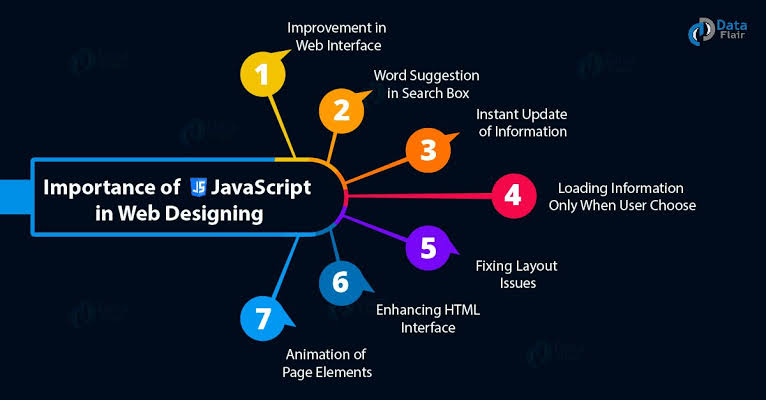Unveiling the Magic of JavaScript: Building Dynamic Web Experiences
 TANVI SHINDODKAR
TANVI SHINDODKAR
In the realm of web development, JavaScript stands as the cornerstone of interactivity and dynamism. This versatile programming language has transformed the way we experience websites, making them not just static pages but interactive and engaging platforms. In this blog, we'll take a journey into the enchanting world of JavaScript, exploring its significance, features, and its role in creating captivating web experiences.
Understanding JavaScript's Significance:
JavaScript, often abbreviated as JS, is a client-side scripting language that empowers web developers to breathe life into their web pages. With JS, you can build responsive features like dynamic content, real-time updates, form validation, animations, and more. As a result, it's the driving force behind modern web applications, giving users a seamless and interactive experience.
Key Features that Fuel JavaScript's Magic:
Event Handling: JS enables developers to capture and respond to various events, such as button clicks, keyboard input, and mouse movements. This capability forms the foundation of interactive user interfaces.
DOM Manipulation: The Document Object Model (DOM) is a representation of a web page's structure. JavaScript allows you to manipulate and modify the DOM, dynamically updating elements without needing to reload the entire page.
Asynchronous Programming: Through techniques like callbacks, promises, and async/await, JavaScript enables non-blocking execution. This is crucial for handling tasks that involve waiting for resources, like fetching data from servers.
Frameworks and Libraries: JavaScript is accompanied by powerful frameworks and libraries like React, Angular, and Vue.js, which streamline the development process and enhance code organization and maintainability.
Crafting Engaging User Experiences:
Interactive Forms: JavaScript lets you validate user inputs in real-time, providing instant feedback to users when they fill out forms. This helps improve data accuracy and user satisfaction.
Dynamic Content Loading: With AJAX (Asynchronous JavaScript and XML), you can fetch data from a server without reloading the entire page. This allows for smoother and faster content updates.
Animations: JavaScript, combined with CSS transitions or libraries like GreenSock Animation Platform (GSAP), empowers developers to create eye-catching animations that capture users' attention and enhance user engagement.
Real-time Updates: Through WebSockets or other technologies, developers can implement real-time updates, making chat applications, collaborative tools, and live data displays possible.
Embracing the Future with JavaScript:
As technology continues to evolve, JavaScript remains at the forefront of innovation in web development. With the rise of Progressive Web Apps (PWAs), serverless architectures, and the increasing demand for responsive and immersive user experiences, mastering JavaScript is essential for any aspiring web developer.
In conclusion, JavaScript isn't just a programming language; it's the catalyst that empowers developers to create dynamic and captivating web experiences. By harnessing its features and capabilities, you can transform static web pages into interactive journeys that delight users and keep them engaged. So, whether you're a beginner taking your first steps or an experienced developer looking to stay ahead, embracing the magic of JavaScript will undoubtedly take your web development skills to new heights.
Remember, the web is your canvas, and JavaScript is the paintbrush that lets you create masterpieces of interactivity and innovation. Happy coding!
JavaScript, often abbreviated as JS, is a client-side scripting language that empowers web developers to breathe life into their web pages. With JS, you can build responsive features like dynamic content, real-time updates, form validation, animations, and more. As a result, it's the driving force behind modern web applications, giving users a seamless and interactive experience.
Key Features that Fuel JavaScript's Magic:
Event Handling: JS enables developers to capture and respond to various events, such as button clicks, keyboard input, and mouse movements. This capability forms the foundation of interactive user interfaces.
DOM Manipulation: The Document Object Model (DOM) is a representation of a web page's structure. JavaScript allows you to manipulate and modify the DOM, dynamically updating elements without needing to reload the entire page.
Asynchronous Programming: Through techniques like callbacks, promises, and async/await, JavaScript enables non-blocking execution. This is crucial for handling tasks that involve waiting for resources, like fetching data from servers.
Frameworks and Libraries: JavaScript is accompanied by powerful frameworks and libraries like React, Angular, and Vue.js, which streamline the development process and enhance code organization and maintainability.
Crafting Engaging User Experiences:
Interactive Forms: JavaScript lets you validate user inputs in real-time, providing instant feedback to users when they fill out forms. This helps improve data accuracy and user satisfaction.
Dynamic Content Loading: With AJAX (Asynchronous JavaScript and XML), you can fetch data from a server without reloading the entire page. This allows for smoother and faster content updates.
Animations: JavaScript, combined with CSS transitions or libraries like GreenSock Animation Platform (GSAP), empowers developers to create eye-catching animations that capture users' attention and enhance user engagement.
Real-time Updates: Through WebSockets or other technologies, developers can implement real-time updates, making chat applications, collaborative tools, and live data displays possible.
Embracing the Future with JavaScript:
As technology continues to evolve, JavaScript remains at the forefront of innovation in web development. With the rise of Progressive Web Apps (PWAs), serverless architectures, and the increasing demand for responsive and immersive user experiences, mastering JavaScript is essential for any aspiring web developer.
In conclusion, JavaScript isn't just a programming language; it's the catalyst that empowers developers to create dynamic and captivating web experiences. By harnessing its features and capabilities, you can transform static web pages into interactive journeys that delight users and keep them engaged. So, whether you're a beginner taking your first steps or an experienced developer looking to stay ahead, embracing the magic of JavaScript will undoubtedly take your web development skills to new heights.
Remember, the web is your canvas, and JavaScript is the paintbrush that lets you create masterpieces of interactivity and innovation. Happy coding!
Subscribe to my newsletter
Read articles from TANVI SHINDODKAR directly inside your inbox. Subscribe to the newsletter, and don't miss out.
Written by
